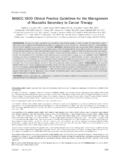Transcription of BTS guidelines for the management of …
1 Downloaded from on July 16, 2011 - Published by ii39. BTS guidelines for the management of spontaneous pneumothorax M Henry, T Arnold, J Harvey, on behalf of the BTS Pleural Disease Group, a subgroup of the BTS Standards of Care Committee .. Thorax 2003;58(Suppl II):ii39 ii52. 1 INTRODUCTION airway obstruction, mediated by an influx of pneumothorax is defined as air in the pleural inflammatory cells, often characterises pneumo- space that is, between the lung and the chest thorax and may become manifest in the smaller Primary pneumothoraces arise in otherwise airways of men at an earlier Patients with healthy people without any lung disease. Second- primary pneumothoraces tend to be taller than ary pneumothoraces arise in subjects with under- control 14 The gradient in pleural lying lung disease.
2 The term pneumothorax was pressure increases from the lung base to the first coined by Itard, a student of Laennec, in apex,1 thus alveoli at the lung apex in tall 1803,2 and Laennec himself described the clinical individuals are subject to significantly greater picture of pneumothorax in He described distending pressure than those at the base of the most pneumothoraces as occurring in patients lung and, theoretically, are more predisposed to with pulmonary tuberculosis, although he recog- the development of subpleural Strong nised that pneumothoraces also occurred in emphasis should be placed on the relationship otherwise healthy lungs, a condition he described between smoking and pneumothorax in an effort as pneumothorax simple.
3 The modern descrip- to deter those smokers who have developed a tion of primary spontaneous pneumothorax pneumothorax from smoking. Despite the appar- occurring in otherwise healthy people was pro- ent relationship between smoking and pneumo- vided by Kjaergard in Primary pneumotho- thorax, 80 86% of young patients continue to rax remains a significant global problem, occur- smoke after their first primary ring in healthy subjects with a reported incidence The risk of recurrence of primary pneumothorax of 18 28/100 000 per year for men and 6/ is 54% within the first 4 years, with isolated risk 100 000 per year for 5 Secondary pneu- factors including smoking, height in male mothorax is associated with underlying lung dis- patients,14 17 and age over 60 Risk factors ease.
4 Whereas primary pneumothorax is not. By for secondary pneumothorax recurrence include definition, there is no apparent precipitating age, pulmonary fibrosis, and 18. event in either. Hospital admission rates for com- In an effort to standardise treatment of bined primary and secondary pneumothorax are primary and secondary pneumothoraces, the reported in the UK at between 000 per British Thoracic Society (BTS) published guide- year for women and 000 per year for lines for the treatment of both in Several men. Mortality rates in the UK were studies suggest that compliance with the 1993. per year for women and per year for guidelines , though improving, remains at only men between 1991 and This guideline 20 40% among non-respiratory and A&E.
5 Describes the management of spontaneous pri- 22 Clinical guidelines have been shown to mary and secondary pneumothorax . It excludes improve clinical practice23 24; compliance with the management of trauma. Algorithms for the guidelines is related to the complexity of practical management of spontaneous primary and sec- procedures that are described25 and is strength- ondary pneumothorax are shown in figs 1 and 2. ened by an evidence Steps in the 1993. Strong emphasis should be placed on the guidelines which may need clarification include: relationship between the recurrence of (1) simple aspiration (thoracocentesis) versus pneumothorax and smoking in an effort intercostal tube drainage (tube thoracostomy) as to encourage patients to stop smoking.
6 The first step in the management of primary and [B] secondary pneumothoraces, (2) treatment of eld- Despite the absence of underlying pulmonary erly pneumothorax patients or patients with disease in patients with primary pneumothorax , underlying lung disease, (3) when to refer subpleural blebs and bullae are likely to play a role patients with a difficult pneumothorax to a chest in the pathogenesis since they are found in up to physician or thoracic surgeon for persistent air 90% of cases of primary pneumothorax at thora- leak or failure of re-expansion of the lung, and (4). coscopy or thoracotomy and in up to 80% of cases treatment of the recurrent pneumothorax . This on CT scanning of the 8 The aetiology of guideline addresses these issues.
7 Its purpose is to See end of article for such bullous changes in otherwise apparently provide a comprehensive evidence based review authors' affiliations healthy lungs is unclear. Undoubtedly, smoking of the epidemiology, aetiology, and treatment of .. pneumothorax to complement the summary plays a role9 11; the lifetime risk of developing a Correspondence to: pneumothorax in healthy smoking men may be guidelines for diagnosis and treatment. Dr M Henry, The General as much as 12% compared with in non- Infirmary at Leeds, Great smoking This trend is also present, though 2 CLINICAL EVALUATION AND IMAGING. George Street, Leeds LS1 3EX, UK; to a lesser extent, in There does not Expiratory chest radiographs are not rec- appear to be any relationship between the onset ommended for the routine diagnosis of.
8 Of pneumothorax and physical Small pneumothorax . [B]. Downloaded from on July 16, 2011 - Published by ii40 Henry, Arnold, Harvey Primary pneumothorax Start Breathless and/or rim of air > 2 cm NO. on chest radiograph ? (section ). YES. Aspiration YES. ?Successful (section ). NO. Consider repeat aspiration YES. ?Successful (section ). NO. Intercostal drain Remove 24 hours after YES. ?Successful full re-expansion/cessation (section ) of air leak without clamping NO. Referral to chest physician within 48 hours Consider ?Suction (section ). discharge Referral to thoracic surgeon (section ). after 5 days (section ). Figure 1 Recommended algorithm for the treatment of primary pneumothorax .
9 Downloaded from on July 16, 2011 - Published by BTS guidelines for the management of spontaneous pneumothorax ii41. Secondary pneumothorax Start Aspiration Breathless + age > 50 years NO. + rim of air > 2 cm ?Successful (section ). on chest radiograph ? (section ). NO. YES YES. Intercostal drain Admit to hospital for ?Successful 24 hours (section ) YES. NO. Referral to chest physician after 48 hours Remove 24 hours after Consider YES. ?Suction (section ) full re-expansion/cessation discharge of air leak (section ). ?Successful NO. Early discussion with surgeon after 3 days (section ). Figure 2 Recommended algorithm for the treatment of secondary pneumothorax . Downloaded from on July 16, 2011 - Published by ii42 Henry, Arnold, Harvey A lateral chest or lateral decubitus radiograph methods of estimating size from PA chest radiographs are should be performed if the clinical suspicion of cumbersome and generally used only as a research The pneumothorax is high, but a PA radiograph is size of a pneumothorax , in terms of volume, is difficult to normal.
10 [B] assess accurately from a chest radiograph which is a two CT scanning is recommended when differentiating a dimensional image. In the 1993 guidelines19 pneumothoraces pneumothorax from complex bullous lung disease, were classified into three groups: when aberrant tube placement is suspected, and small : defined as a small rim of air around the lung ;. when the plain chest radiograph is obscured by moderate : defined as lung collapsed halfway towards surgical emphysema. [C] the heart border ; and The clinical history is not a reliable indicator of complete : defined as airless lung, separate from the dia- pneumothorax size. [C] phragm . Clinical history and physical examination usually suggest the This attempt to quantify a pneumothorax tends to underesti- presence of a pneumothorax , although clinical manifestations mate the volume of anything greater than the smallest of are not reliable indicators of 30 In general, the clinical Since the volume of a pneumothorax symptoms associated with secondary pneumothoraces are approximates to the ratio of the cube of the of the lung diam- more severe than those associated with primary pneumotho- eter to the hemithorax diameter, a pneumothorax of 1 cm on races.



